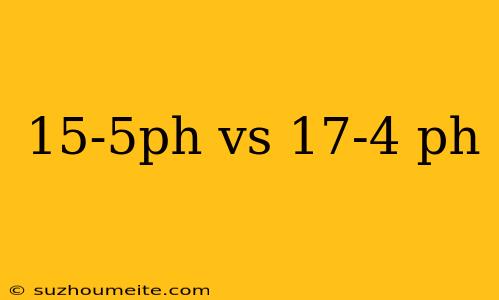15-5PH vs 17-4PH: Comparison of Stainless Steel Grades
When it comes to selecting the right stainless steel grade for a particular application, it can be overwhelming due to the numerous options available. Two popular grades of stainless steel, 15-5PH and 17-4PH, are often considered for their high strength, corrosion resistance, and versatility. In this article, we will delve into the differences between these two grades and explore their unique characteristics, advantages, and disadvantages.
What is 15-5PH Stainless Steel?
15-5PH is a precipitation-hardening stainless steel alloy that contains 14.0-15.5% chromium, 3.5-5.5% nickel, 0.50-1.25% copper, and 0.10-0.60% carbon. This alloy is known for its high strength, resistance to corrosion, and excellent weldability. 15-5PH is often used in aerospace, chemical processing, and high-temperature applications.
What is 17-4PH Stainless Steel?
17-4PH is a precipitation-hardening stainless steel alloy that contains 15.0-17.5% chromium, 3.0-5.0% nickel, 3.0-5.0% copper, and 0.07% carbon. This alloy is known for its high strength, resistance to corrosion, and excellent fatigue resistance. 17-4PH is often used in aerospace, chemical processing, and high-temperature applications.
Comparison of 15-5PH and 17-4PH
Here's a summary of the key differences between 15-5PH and 17-4PH stainless steel grades:
Chemical Composition
| Element | 15-5PH | 17-4PH |
|---|---|---|
| Chromium | 14.0-15.5% | 15.0-17.5% |
| Nickel | 3.5-5.5% | 3.0-5.0% |
| Copper | 0.50-1.25% | 3.0-5.0% |
| Carbon | 0.10-0.60% | 0.07% |
Mechanical Properties
| Property | 15-5PH | 17-4PH |
|---|---|---|
| Yield Strength | 1150-1350 MPa | 1200-1400 MPa |
| Tensile Strength | 1380-1580 MPa | 1450-1650 MPa |
| Elongation | 10-15% | 10-15% |
| Hardness | 40-45 HRC | 40-45 HRC |
Corrosion Resistance
Both 15-5PH and 17-4PH exhibit excellent corrosion resistance in various environments, including acidic and alkaline media. However, 17-4PH has slightly better resistance to pitting and crevice corrosion due to its higher chromium content.
Applications
Both grades are suitable for aerospace, chemical processing, and high-temperature applications. However, 15-5PH is often preferred for its better weldability and lower cost. 17-4PH is commonly used in more critical applications where its higher strength and corrosion resistance are essential.
Conclusion
In conclusion, both 15-5PH and 17-4PH are high-performance stainless steel grades with excellent mechanical properties and corrosion resistance. While they share many similarities, the differences in chemical composition, mechanical properties, and applications make 15-5PH a more cost-effective and weldable option, and 17-4PH a better choice for critical applications requiring high strength and corrosion resistance.
